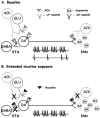It is not "either/or": activation and desensitization of nicotinic acetylcholine receptors both contribute to behaviors related to nicotine addiction and mood
- PMID: 18242816
- PMCID: PMC2390914
- DOI: 10.1016/j.pneurobio.2007.12.005
It is not "either/or": activation and desensitization of nicotinic acetylcholine receptors both contribute to behaviors related to nicotine addiction and mood
Abstract
Nicotine can both activate and desensitize/inactivate nicotinic acetylcholine receptors (nAChRs). An ongoing controversy in the field is to what extent the behavioral effects of nicotine result from activation of nAChRs, and to what extent receptor desensitization is involved in these behavioral processes. Recent electrophysiological studies have shown that both nAChR activation and desensitization contribute to the effects of nicotine in the brain, and these experiments have provided cellular mechanisms that could underlie the contribution of both these processes to nicotine-mediated behaviors. For instance, desensitization of nAChRs may contribute to the salience of environmental cues associated with smoking behavior and activation and desensitization of nAChRs may contribute to both primary and conditioned drug reward. Similarly, studies of the antidepressant-like effects of nicotinic agents have revealed a balance between activation and desensitization of nAChRs. This review will examine the evidence for the contribution of these two very different consequences of nicotine administration to behaviors related to nicotine addiction, including processes related to drug reinforcement and affective modulation. We conclude that there are effects of nAChR activation and desensitization on drug reinforcement and affective behavior, and that both processes are important in the behavioral consequences of nicotine in tobacco smoking.
Figures

References
-
- Benowitz NL, Porchet H, Jacob P., 3rd Nicotine dependence and tolerance in man: pharmacokinetic and pharmacodynamic investigations. Prog Brain Res. 1989;79:279–87. - PubMed
-
- Benwell ME, Balfour DJ, Anderson JM. Evidence that tobacco smoking increases the density of (-)-[3H]nicotine binding sites in human brain. J Neurochem. 1988;50:1243–7. - PubMed
Publication types
MeSH terms
Substances
Grants and funding
- R01 MH077681/MH/NIMH NIH HHS/United States
- P50 AA015632/AA/NIAAA NIH HHS/United States
- K02 DA000436/DA/NIDA NIH HHS/United States
- DA 00436/DA/NIDA NIH HHS/United States
- P50 DA013334/DA/NIDA NIH HHS/United States
- DA 13334/DA/NIDA NIH HHS/United States
- AA 15632/AA/NIAAA NIH HHS/United States
- R01 DA014241/DA/NIDA NIH HHS/United States
- R01 DA010455/DA/NIDA NIH HHS/United States
- DA 10455/DA/NIDA NIH HHS/United States
- R29 DA010455/DA/NIDA NIH HHS/United States
- R37 DA014241/DA/NIDA NIH HHS/United States
- MH 77681/MH/NIMH NIH HHS/United States
- DA 14241/DA/NIDA NIH HHS/United States
LinkOut - more resources
Full Text Sources

